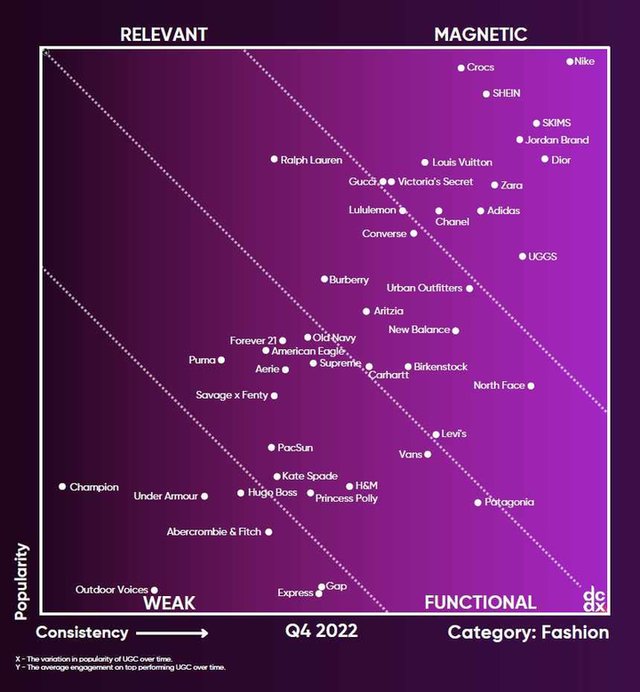
Are you a Magnetic Gen Z Brand?
Fashion brands are on the verge of a monumental shift. Amid accelerating micro-trend cycles, a push for individualization, and encompassed by fields of moral dilemmas around sustainability and brand values, fashion has never been as diverse as it is today.
These increasingly diverse subcultures speak to the challenge of the modern-day fashion brand; how do we keep up with the speed of culture while maintaining the integrity and value of the brand? As these questions continue into 2023, virtual fashion and an economic downturn will introduce new challenges, alongside the ever-evolving shifts in consumer behavior. 2023 will make explicit the fashion brands fighting to survive and those poised to thrive.
By analyzing 44 brands across the fashion industry, dcdx identified key themes that drive conversation from young people around fashion brands. These themes can lead to brands attracting consistently popularity conversation (what we call Magnetism). Here are two of the major themes we found in this year’s analysis:
I. Brand Collaborations: in an era of fashion where both novelty and vintage preside as dominant themes, collaborations enable brands to tap into new audience segments, while simultaneously creating both elements of novelty and rarity through limited quantity offerings.
Two examples of brand collaborations that drove conversation for Gen Z:
- Crocs x SZA: 2 collaborations in 2022 drove high levels of conversation for the brand, with SZA’s Crocs selling out nearly instantly both times they were released. A nostalgia-influenced design in their most recent “Cozzzy” sandal, Gen Z’ers flocked to TikTok to share their new denim-printed shoes.
- Vans x Stranger Things: following the release of #StrangerThings4, Vans launched a limited edition shoe paying tribute to the Hellfire Club and driving Gen Z’ers online to talk and share unboxings of the new shoes.
Competition for Gen Z attention is intensifying. To attract young consumers, top fashion brands are relying on innovation and experimentation as a competitive advantage.
II. Accessible and Inclusive: recent brand pushes around size inclusivity and accessibility to the brand have enabled and empowered all different types of young people to engage with and create content around the brand. A shift towards diverse and accessible modeling has led to not just a movement around body positivity, but increasing comfort in who you are and what you wear.
Two examples of accessible and inclusive efforts from fashion brands:
- SKIMS: Since launching in 2019, Kim K’s fashion line has had inclusivity built in to the core of the brand. SKIMS focuses on including customers of all body types, using models of diverse sizes and shapes to promote an accessible and inclusive culture around the brand.
- Victoria’s Secret: after its 2021 rebrand, Victoria’s Secret’s big focus on inclusivity has continued alongside its recent acquisition of Adore Me, giving the brand a technology-enabled push toward accessible and inclusive options for all.
What we saw overall from the top fashion brands this year was their ability to attract young consumers in, using innovation and experimentation as a competitive advantage. Nike, Crocs, and SHEIN were also featured in this year’s Top 25 Overall Gen Z brands ranking from dcdx, showing their ability to compete for Gen Z attention beyond the world of fashion and retail. As disposable income grows for this generation, their brand choices will become more defined and more pronounced, with the distance between Relevant and Magnetic Brands growing farther and farther apart.





Andrew Roth is the Founder and CEO at dcdx, a Gen Z consulting firm. As a Gen Z'er himself, Andrew's purpose in starting the company was to bring Gen Z voices to the table. This has led Andrew and the dcdx team to build a network of over 100,000 Gen Z'ers, enabling their work with some of the world's top brands like Google, Chipotle, Denny's, Hinge and more. For more info, visit dcdx.co